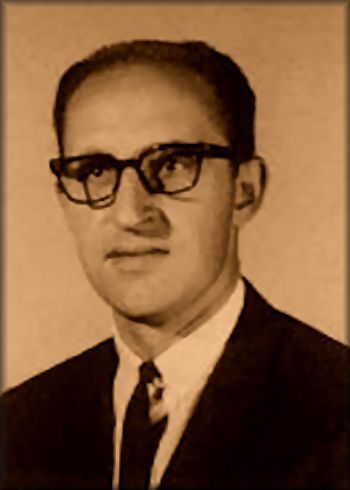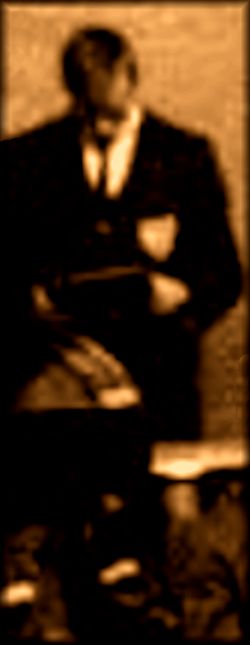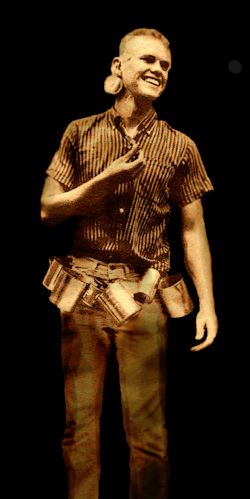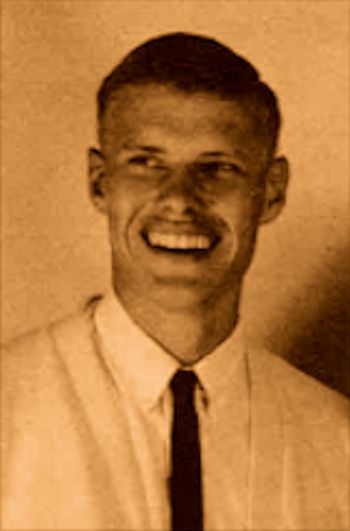|
|
|
|
|
Music Educator, Fine Arts Leader,
BYU Museum of Art Founder
|
|
|
Brigham Young High School
Music Faculty 1957-1962
|
|
|
|
James A. Mason --
An Appreciation from a Tone-deaf Percussionist
|
|
|
By John M. Paxman, BYH Class of 1962
|
|
I lived in Lexington, Massachusetts for over twenty years, now spend most of the time in Montreal. While in Lexington we periodically went over to the Unitarian Church on Battle Green to take in a service -- it’s another of those uniquely American churches with its roots deep in the American Revolution, then later in transcendentalism -- influences of Emerson, Thoreau, Hawthorne and the Boston Brahmins.
The church building, pristine white New England clapboard and 175-foot steeple, stands on the west side of the Common where the Minutemen first confronted the British Army in April, 1775 as it marched to Concord to destroy an arms cache.
Each Spring the Unitarians sponsored a Music Sunday. That service was always well worth attending, for the spring ambience as much as the music. In 2006 we arrived a little late, took seats at the very back, well under the balcony, the choir loft. There was the better part of a small orchestra gathered at the front -- it was very much like the “stand” area of early Mormon churches, not quite as grand as the Provo Tabernacle, but still appealing with its organ pipes also rising as a backdrop.
I was just settling in, looking at the program, when the thunder of tympani, drums and cymbals, crashed from the loft overhead -- boom, boom-boom. Three repetitions in descending volume. Then a bugle-like call of trumpets and french horns, da da daaaaa, da da daaaaa, . . . da da da da da da-da, boom-boom, the da-da and the boom-boom coming together at the end of the phrase. “I know that piece,” I thought. “I've played it!” Aaron Copeland's Fanfare for the Common Man.
|
|
I immediately thought of James A. Mason, the man who had taught me to play the tympani part of that exciting piece as part of the BY High School Concert Band. I can still see his strong signature on my music report card. As I sat there for the rest of the concert, I began to think about what an extra-ordinary experience it had been for a young kid in the hinterlands of Utah to be exposed to the kind of “culture” of music that Mason brought into our lives. I think many others among those “kids” feel the same appreciation to him.
|

James Mason 1962 |
|

|
The only known photograph of
John Paxman, BYH Class of 1962,
playing the tympani.
|
|
Think about it. Fanfare for the Common Man was composed in the early-1940s, in the midst of the World War, hence, I suspect the cannon and reveille-like centerpiece. Typically the percussion section supports a piece of music, punches the rhythm along, undergirds melodies, provides accent, counterpoint. Rarely is it featured.
Copeland must have loved percussion, at least for the moments he worked on Fanfare. Forget about the brass section, they are always prominent, as are the winds. For this one piece though, Mason, through Copeland, made all-stars of our little group of drum beaters—Neil Whiteford, David Adamson, Kent Bunker. Maybe Jim Kirkman was there too.
In those years, Mason chose other pieces that showed the power of the percussion. One featured a huge gong, played at the time by Smoot Pierpont. The force of the beginning strokes at the opening of that piece -- I forget the name -- caused dust to rain down from the baffles and high corners of the old auditorium in Pleasant Grove during a music competition!
It was too much fun -- boom-boom-boom, bang bang bang! We at B. Y. High School enjoyed this kind of activity, and the drama and debate, where we would routinely excel, trounce opposing high schools no matter their size. Being the smallest of schools, we usually didn’t do as well in sports, except in basketball and tennis.
And there was more from Mason. He taught us pieces like Bela Bartok's Bear Dance, with its bulky, near stupifying, asymmetrical rhythmic energy. I think it was Hal Hullinger who played the string bass for that piece, which provided, along with the tuba, baritone and trombone, the voice of the lumbering bear. Only later, when I worked in Romania, did I learn that this piece was fashioned on a folksong.
We played part of Ferde Grofe's Grand Canyon Suite, that wonderfully western piece with the movement down into the Canyon and the braying of donkeys, and the Deep River Suite, with its evocation of the Negro Spiritual. This we performed jointly, I believe, with Fred Webb's choir.
And then there was the solemnity of Wagner's Elsa's Procession to the Cathedral, featuring the brass, from the opera Lohegrin, and Bach's Prelude and Fugue in G Minor. I think we learned at least one piece by Dvorzak, probably part of the New World Symphony.
Though not exactly the removed cultural outpost that many might think, Utah Valley it turns out, thanks to Mason, was not very far away from the supposed cultural sophistication of the East and West Coast scenes. Mason lifted us to that level, put a bunch of high school students on the very cutting edge of 20th century orchestral music.
You get the point. Mason was very good for us. Because of him, I imagine that we were nearly as “with it” as we would ever be, as those were the later days of Elvis and the dawning of the Beatles.
I cannot recall all of the others in the band, but there were some very good musicians. They were better when Mason finished with them.
|
|
|
Instrumental music captivated the audience as the Concert Band presented their powerful Winter Concert. With James Mason conducting, BYH had one of the finest instrumental groups in the area. This was shown at regional competition where they received 1 ratings.
|
|
|
|
CONCERT BAND: Flute: Helen Gardner, Sue Ann Elliott, Karen Taylor, Gina Grow, Marcia Ann Nelson, Susan Fuhriman. Oboe: George Taylor, Joe Clark. Clarinet: David Clark, Verdun Watts, David Wonnacott, Barbara Stringfellow, Sharlene Wolsey, Edward Beck, Jamie Chandler, Corbin Clark. Cornet and Trumpet: David Payne, Francis Rogers, Ray Ashby, Glen Anderson, James Clark, Hansford Denys, Robert Huish. Tuba: Paul Felt, David Braithwaite. Percussion: John Paxman, George Pierpont, Neal Whiteford, Brent Yorgason, Kent Bunker. Piano: Susan Bankhead. Harp: Carolyn Paxman. Conductor: James Mason. 1962 Wildcat Yearbook, p. 84
|
|
|
Some of our high school band members were a year or two older than I. David Payne and Roy Taylor on the trumpet; Steve Worsley, the fluegelhorn; Helen Gardner, Sue Ann Elliot, and Gina Grow, the flute; Alec Andrus, saxophone; Kay Reimschissel, Joe Clark and George Taylor, oboe. We even had a bassoonist: Doyle Davis!
Kim Bateman, Stephen Clark and Bob Martin played the trombone. Bob was first rate as I remember. He lived in my neighborhood and would often play at the Fifth Ward House before brass instruments were banned for their irreverence from sacrament meetings. What was that all about anyway? Whoever authored that policy never heard Bob play “Oh, Holy Night” or “Jerusalem”.
Paul Felt and Bob Huish tackled the tuba. And there was Elin Crnkovic, Paul Van Wagonen and Newt Andrus, another kid from my neighborhood and life-long friend, on the clarinet. Elin and Newt were always locked in a competition for first chair, which Mason deftly avoided by changing the seating arrangements from time to time so no one could discern who was on first -- there is a joke there, I’m sure.
I think Newt Andrus was actually recruited from Provo High by Mason through his summer school music classes, and he switched high schools to be with us. Even as a student, Newt was good enough to play in the dance band that faculty member Dick Ballou organized.
But the best musician of our time was probably Ralph “Chip” Woodward. Ralph played the french horn, as did Mason, had a true musician's pedigree through his father, went on to play with orchestras in Europe and the US, then returned to Utah to organize and lead the highly regarded Salt Lake Children's Choir. Along the way, he played with jazz greats Chuck Mangione and J.J. Johnson, and collaborated with Pete Seegar, among others.
For our BYH marching band, Mason had other fun and challenges in store for the percussionists. He brought to us an exciting set of drum cadences -- sophisticated, counter-pointed, call-and-response.
Though nothing was improvised, they were almost hip before hip and hop were important to Utahns. To match the cadences, he introduced a new set of drums: tenor, snares, bass. Even at this distance in time, I can still tap out each of the four segments of the cadences used by the various drums.
Mason had us rocking even as rock was coming into vogue. He put our rhythm section on a par, I think, with that of Ogden’s Ben Lomond High School, perennially the state's best marching band, with their spiffy Scottish uniforms, tartan kilts, all their bonnie lasses and their tight drum cadences drawn from the tradition of the British military tattoos.
We were so good that people, I swear, ignored our appalling gray uniforms -- bound by our school colors, gold and grey.
Newt Andrus reminds me that we were fearless, disciplined marchers. During one stint in Logan, the late-fall wind was so fierce that it blew the banner carriers and majorettes right off the road! Picture sail gliding!
I think that was the same time that while we were trying to make a turn, but starting late, we marched right into the crowd on the corner but continued marching and turning. More than a few people got hit in the head with flying drumsticks: rabbit hutch, rabbit hutch, one two three!
|
|

Paxman, tin can percussionist |
Truth be told, at the end of the day, I had very little musical talent. This would be one of the reasons I was carefully channeled into the percussion section. Even my parents had picked up on this early, and gave me a drum to pound on while my sisters all got piano lessons. |

John Paxman, ASB President, 1962 |
|
One of my sisters, Carolyn Paxman Bentley, even got a harp, became a professional harpist -- and by that I do not mean that she complains a lot for a living :-)
I recall that Mason took part of his summers to help me, and others, perfect our music and drumming techniques. He built on what Gus Shields had managed to do with us during the junior high years. He worked with me to perfect my “rudiments” -- believe it or not, there are 40 of them. I don't think I could ever do all of them, but to this day I know about flams, paradiddles -- even those with drag -- and rolling flamacues! Long live the rudiments!
Mason was already deep into his first specialty, music education. And he was superb at it. On a personal level, I appreciated, and still do, the fact that Mason made me feel that I was a “musician” -- that I knew what I was doing, that I could actually read music, well rhythm anyway, that I was capable of helping to make music.
He patiently taught me how to use the tuning forks, or mouth piece tuner, to tune the kettles just in case I couldn't pick up the note from the orchestra, which surely I never could. Neither the tuner nor the mouth piece could overcome my inability to hear the tones.
I am pretty certain to this day that I rarely got it right. Even so, he tolerated and encouraged me through two whole years of being out of tune! That sort of ignoring made a huge difference to me. Even out of tune I was proud of what I was doing. Not that I recommend living without being aware.
It would only be later in life that I would work on getting things right. My father says each time he now hears the overture to Wagner’s Die Meistersinger, and its tympani part dut, da da da, he thinks of the fact that I once played the instrument for Mason.
James Mason’s people skills were also extraordinary. Fifty years on, my parents report that he never failed to greet them and chat when he would see them at a BYU music event. Several of my peers note the same. Gosh, we were just little minions in a high school band, but he recalls details of our lives and always shows a gentle interest in what we are doing, have done. There was a cultured European elegance to it all, something I have not witnessed very often during my life.
After his five years at BY High, James Mason went on to do what the outside world would count as much more remarkable things. In his profession, he spent nearly 40 years affiliated with BYU, climbed to lofty places.
His BYU faculty profile had him teaching at BYU, and several other famous music universities -- Northwestern, Indiana, Texas, the Cincinnati Conservatory, founding and editing magazines for music educators, spending time in Washington D.C, where among other things he led the association that looked after the interests some 65,000 music educators in the US.
He became Dean of the College of Fine Arts at BYU, then oversaw the establishment of the BYU Museum of Fine Arts, and was its first Director. He once gave me an personalized tour of the ancient and oriental musical instruments collection he had assembled. I could feel him enthuse as he described each of the instruments, could tell he loved what he was doing in life.
One memorable detail of the Museum experience is that Mason was told that he could not use either Church or University money to fund its establishment. I can’t imagine why the constraint, but what an incredible feat to raise those millions!
Over time he was given all of the major awards given at BYU -- the Smoot, the Watkins, the Harris. These are singular achievements. All demonstrate praise, respect, admiration.
But for me, the most remarkable thing he did during the early years of his professional life was to enrich the lives of a bunch of kids from the neighborhoods of Provo. He made musicians of us all. And he remembered us, and our details, the rest of his life.
John M. Paxman, Montreal
May 19, 2014
|
|
|
|
|
|
|
|
In Memoriam, James A. Mason
|
|
James Albert Mason was born in Eureka, Utah on January 4, 1929 to Rolla N. and Mary Garn Mason and died on May 15, 2014.
Dr. Mason was the founding director of the Museum of Art at Brigham Young University.
During his forty years at BYU he served as Chair of the Music Department and as Dean of the College of Fine Arts and Communications for eleven years.
As Dean he was able to realize a dream he had for the university -- to build an innovative art museum. This required gaining permission to proceed with this venture as well as fundraising without using any University or Church funds.
After completion of the Brigham Young University Museum of Art he was appointed its founding director. Some of the exhibits were: BYU's treasures, art from the Vatican Museums, Chinese museums, and the Metropolitan Museum of Art.
He grew up in Springville, Utah, across the street from the Springville Art Museum which had an influence on him throughout his life.
His high school years were dominated by music. His studies at Brigham Young University were interrupted to serve in the Armed Forces during the Korean War. He received his bachelors and masters degrees from BYU and his doctoral degree from Arizona State University.
While playing the French horn in the University's orchestra he met and married Lynne Galbraith, a violinist. They were married in the Salt Lake Temple.
He began teaching music in Nebo School District and after completing his master's degree was hired by Brigham Young University High School beginning with the 1957-1958 academic year and continuing for five years.
After five years at BYH he joined the BYU University Music Department. He was given an extended leave for professional activities.
After serving as editor of the Utah Music Educator, he accepted a job in Chicago as editor of the Instrumentalist, a monthly music magazine. He left to complete his doctoral degree.
While teaching at BYU he wrote News of Research column for the Journal of Research in Music Education. He was elected President of the Western Division of the National Organization of Music Educators (MENC) and some years later was elected National President of MENC with more than a 100,000 members.
He taught as a visiting professor at Northwestern University, Indiana University, University of Texas, and Cincinnati Conservatory of Music. He lectured at the Central Conservatory of Music in Beijing, China and was the American speaker at the International Conference on Music Education in Warsaw, Poland.
He served on a number of boards including the Music Education Research Council in Washington, D.C., The Barlow Foundation for Music, The Music Council in New York City, the Music Industry Council in Chicago, the Presser Foundation in Philadelphia, Utah's Statehood Centennial Commission, Utah Opera Board, and Utah Museum Council. He was a co-founder of the Utah Valley Symphony.
During these years of service he received many awards and recognitions: an award from the government of Israel, two awards from Educational Press Association of America, the San Francisco Art Critics Award, the Utah Outstanding Music Educators Award, the Utah Museum Association Award, the Reed Smoot Award, the Arthur Watkins Award, the Franklin S. Harris Award, the BYU Alumni Award, and the Life-time Achievement Award from the Mormon Arts Committee. He has been listed in Who's Who in America.
He served in many callings in The Church of Jesus Christ of Latter-day Saints. In addition to teaching he served as elder's quorum president in three different wards, high councilor in three stakes, bishop in two wards, and on the General Music Committee. He served on an advisory committee for the development of the LDS Conference Center.
Although James achieved international recognition for his professional work, his proudest accomplishment was his dear family. He is survived by his wife of fifty-eight years and his three wonderful children: Julia Johns Davis (Kevin Johns, deceased, and Patrick Davis), Margo Turner (David) and Christopher Mason (Mican), fifteen grandchildren and four great-grandchildren.
He was preceded in death by his two sisters Shirley Mason Beardall and Elaine Mason Rothwell, and a granddaughter, Angela.
A funeral service was held on Thursday, May 22, 2014 at the Sunset Heights LDS 6th Ward in Orem, Utah.
-- Provo Daily Herald, Sunday, May 19, 2014
|
|
|
|
|
|
|
|
|
|
|
|

